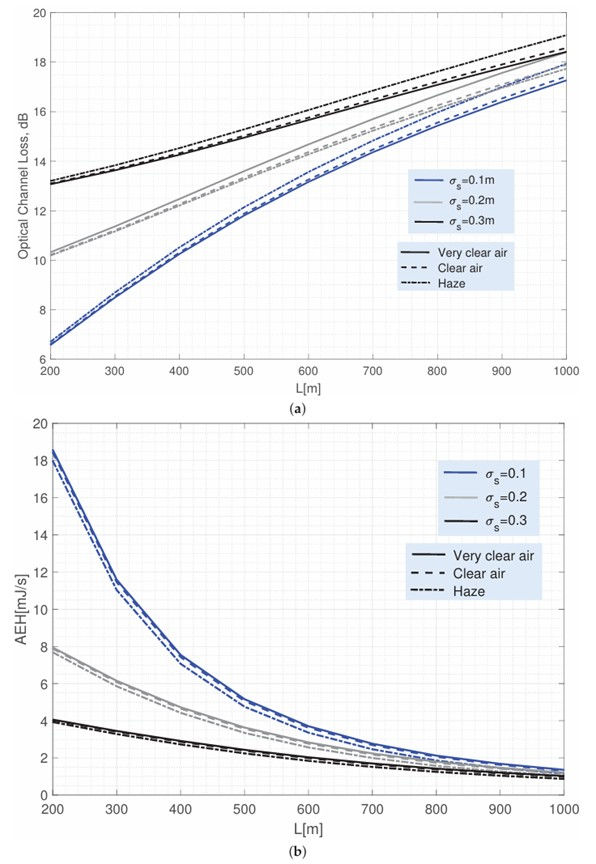Free-Space Optical Communication and Energy Harvesting in 5G+ Networks
- Latitude Design Systems
- Feb 25
- 3 min read
Introduction
Free-space optical communication (FSO) combines the high bandwidth of optical communication with the flexibility of wireless communication. This paper explores how FSO technology, when integrated with unmanned aerial vehicles (UAVs) and energy harvesting techniques, can provide efficient backhaul and fronthaul architectures for 5G and beyond (5G+) networks [1].
System Architecture and Key Devices
The system architecture employs UAVs as relay nodes between base stations and network gateways. Figure 1 illustrates this concept, depicting how FSO links are integrated with UAVs in a 5G+ network environment. This figure illustrates how UAVs establish vertical backhaul/fronthaul connections between base stations and gateways while maintaining line-of-sight communication.

Channel Characteristics and Challenges
FSO communication faces several atmospheric and alignment challenges:
Atmospheric Turbulence: The inhomogeneities in air pressure and temperature lead to variations in the refractive index of the air along the transmission path. This phenomenon results in random signal amplitude and phase variations, leading to fading effects.
Pointing Errors: Misalignment between the transmitter and receiver leads to significant power losses. Figure 2 illustrates how UAV jitter at different altitudes affects the communication link.

Performance Analysis
System performance is evaluated based on two key metrics: bit error rate (BER) and energy harvesting efficiency. Figure 3 presents a comprehensive BER analysis under various channel conditions.

Energy Harvesting Strategies
The energy harvesting module employs an optimized on-off keying (OOK) scheme to enable simultaneous information transmission and energy harvesting. Figure 4 illustrates the receiver architecture integrating communication and energy harvesting modules.

Practical Implementation Considerations
The practical deployment of the system requires careful consideration of the following parameters:
Beam Divergence: A typical transmitter divergence angle of 1 milliradian is used to balance coverage range and power efficiency.
Receiver Design: An optical circular converging lens with a 10 cm aperture radius and 0.5 A/W responsivity is employed.
Operating Conditions: The system operates at a wavelength of 1550 nm and is influenced by various atmospheric conditions.
Figure 5 illustrates the relationship between link length and system performance under different atmospheric conditions.

Results and System Performance
Performance analysis indicates that the proposed system achieves significant energy harvesting while maintaining a reliable communication link. Figure 6 demonstrates the energy harvesting capability under different operating conditions.

Conclusion
The integration of UAVs and energy harvesting in FSO communication systems offers an effective solution for 5G+ network backhaul/fronthaul connectivity. This system provides additional energy harvesting benefits while ensuring reliable performance, though careful consideration of atmospheric conditions and pointing accuracy is required. Technology is particularly advantageous in urban environments where traditional RF solutions may face bandwidth limitations or interference issues.
Key Advantages of This Technology:
High-bandwidth capability with no RF interference
Adaptive network topology enabled by mobile UAV nodes
Extended UAV operation time through energy harvesting
Cost-effectiveness compared to fixed infrastructure
Future research in this field will focus on improving pointing accuracy and enhancing energy harvesting efficiency while maintaining reliable communication performance under diverse atmospheric conditions.
References
[1] Y. Wang and L. Zhang, Eds., "Optical Signal Processing Technologies for Communication, Computing, and Sensing Applications," MDPI Books, 2023. [Online]. Available: https://www.mdpi.com/books/reprint/7078-optical-signal-processing-technologies-for-communication-computing-and-sensing-applications. [Accessed: Dec. 29, 2024]

Comments